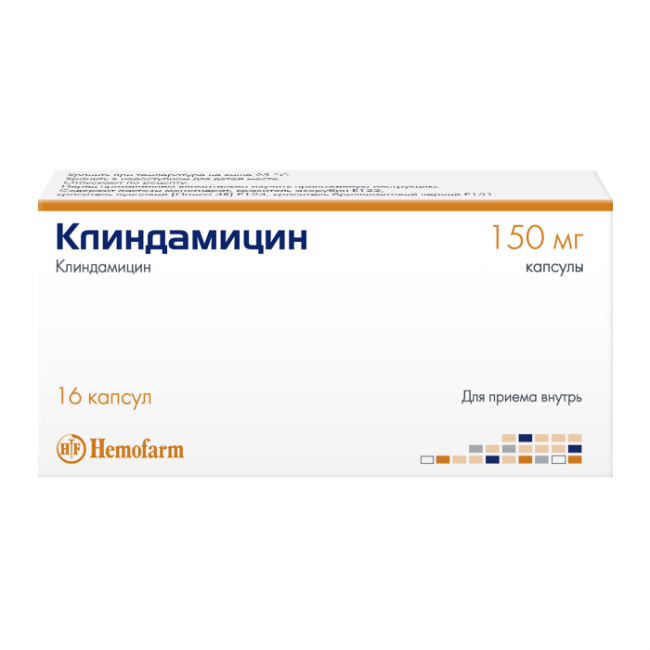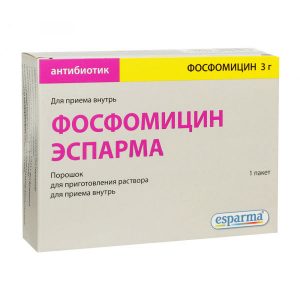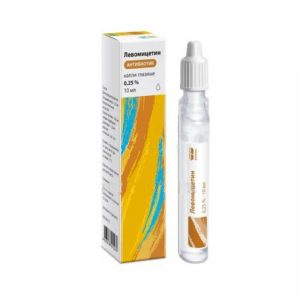Description
Latin name
Clindamicin
Packaging
In a blister pack of 8 capsules. In a cardboard box 2 blisters.
Pharmacological action
Clindamycin is a drug from the antibiotic-linkosamide group, has a wide spectrum of activity, bacteriostatic, binds to the 50S subunit of the ribosome and inhibits protein synthesis in microorganisms.
Active against:
– Staphylococcus spp. (including Staphylococcus epidermidis producing penicillinase).
– Streptococcus spp. (excluding Enterococcus spp.).
– Streptococcus pneumoniae.
– Anaerobic and microaerophilic gram-positive cocci (including Peptococcus spp. and Peptostreptococcus spp.).
– Corynebacterium diphtheriae.
– Clostridium perfringens.
– Clostridium tetani.
– Mycoplasma spp.
– Bacteroidesspp. (including Bacteroides fragilis and Bacteroides melaningenicus).
– Anaerobic, gram-positive, non-spore forming, bacilli (including Propionibacterium spp., Eubacterium spp., Actinomyces spp.).
Most strains of Clostridium perfringens are sensitive to clindamycin, but other types of clostridia (Clostridium sporogenes, Clostridium tertium) are resistant to the drug, therefore, antibiotic determination is recommended for infections caused by Clostridium spp.
In terms of its mechanism of action and antimicrobial spectrum, it is similar to lincomycin (it is 2-10 times more active with respect to certain types of microorganisms, especially against bacteroids and non-spore-forming anaerobes).
Indications
Infectious and inflammatory diseases caused by microorganisms sensitive to clindamycin: – Infections of the upper respiratory tract and infections of the ENT organs
– Pharyngitis.
– Tonsillitis.
– Sinusitis.
– Otit.
– Pneumonia, incl. aspiration.
– Abscess of the lung.
– Empyema of the pleura.
– Bronchitis.
– Chlamydia.
– Endometritis.
– Vaginal infections.
– Tubo-ovarian inflammation.
– Infected wounds.
– Abscesses.
– Boils.
– Panaritius.
– Abdominal cavity: – Peritonitis.
– Abscess.
Contraindications
– Myasthenia gravis.
– Bronchial asthma.
– Ulcerative colitis (history).
– Rare hereditary diseases, such as galactose intolerance, lactase deficiency or glucose-galactose malabsorption (for capsules).
– Pregnancy.
– Lactation.
– Children’s age up to 8 years for capsules (average child weight less than 25 kg).
– Hypersensitivity.
Use with caution in patients with:
– Severe hepatic and / or renal failure.
– In elderly patients.
Pregnancy and lactation
Contraindicated
Composition
1 capsule contains:
Clindamycin (in the form of hydrochloride) 150 mg.
Excipients:
Corn starch,
Lactose monohydrate,
Talc,
Magnesium stearate.
Capsule body composition:
Dye azorubine (E122),
Dye black diamond (E151),
Gelatin.
Composition of the capsule cap:
Titanium dioxide (E171),
Quinoline dye yellow (E104),
Azorubine dye (E122),
Punzo dye Ponceau 4R (E124),
Dye brilliant black s, Yellow ( 15.
Dosage and administration of
– Inside, adults and children over 15 years old (average child weight 50 kg and above) for moderate diseases, 1 capsule (150 mg) is prescribed 4 times / day (every 6 hours).
– In severe infections, adults and children over 15 years of age, a single dose can be increased to 2-3 capsules (300-450 mg).
– For children from 8 years to 15 years, the method of use of capsules is shown in the table.
When i / m and iv, the recommended dose:
– For adults – 300 mg 2 times / day. In severe infections – up to 1.2-2.7 g / day, divided into 3-4 injections.
– For children over 3 years of age – 15-25 mg / kg / day, divided into 3-4 equal doses. In severe infections, the daily dose can be increased to 25-40 mg / kg body weight, divided into 3-4 identical injections.
Patients with severe hepatic and / or renal insufficiency do not need to adjust the dosage regimen if the drug is prescribed with an interval of at least 8 hours.
Drug interaction
Clindamycin enhances the (mutually) effect of rifampicin, aminoglycosides, streptomycin, gentamicin (especially in the treatment of osteomyelitis and the prevention of peritonitis after intestinal perforation).
Enhances the effects of competitive muscle relaxants, and also enhances the muscle relaxation caused by n-anticholinergic blockers.
Incompatible with ampicillin, barbiturates, aminophylline, calcium gluconate and magnesium sulfate.
Antagonizes erythromycin and chloramphenicol.
The simultaneous use with solutions containing a complex of B vitamins, aminoglycosides, phenytoin is not recommended.
Concomitant use with antidiarrheal drugs increases the risk of pseudomembranous colitis.
With simultaneous use with opioid (narcotic) analgesics, it is possible to increase the respiratory depression caused by them (up to apnea).
Overdose
– Symptoms: Possible side effects may increase.
– Treatment: symptomatic therapy, no specific antidote. Hemodialysis and peritoneal dialysis are ineffective.
Storage Conditions
– Store at 15-25 ° C.
– Keep out of the reach of children.
– Do not use after expiration date.
Shelf life
3 years.
Deystvuyushtee substance
Clindamycin
Terms and conditions
prescription
Dosage form
cap uly
Prescription
Prescription
Adults for prescribed doctors, Children over 8 years old, For children prescribed by a doctor



